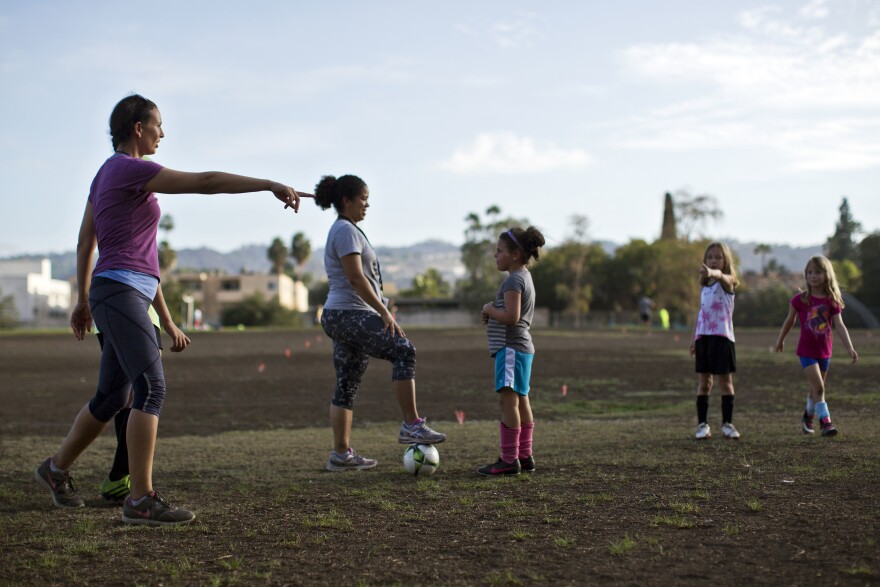With our free press under threat and federal funding for public media gone, your support matters more than ever. Help keep the LAist newsroom strong, become a monthly member or increase your support today .
Dirty restrooms taint LA city park grades

Dirty restrooms and safety concerns dragged down the quality of Los Angeles city parks to an overall grade of B-minus on a new report card issued Wednesday by City Controller Ron Galperin.
An independent firm hired by Galperin’s office examined 40 of the city’s 95 community parks, evaluating them much as any parent would – Are the restrooms in order? Do the drinking fountains work? Is my child safe here?
Galperin concludes in the new report the city is struggling to maintain parks in good, safe condition mostly because of financial reasons. The Recreation and Parks Department has seen its staff cut by one-third since 2008 and its budget reduced by as much as $81 million, Galperin said.
“It's very hard to expect that you're going to get more cleanliness and more service with fewer people and fewer dollars,” Galperin said. “And we've got to address that as a city."
Galperin called on the city Recreation and Parks Department to be more proactive in scheduling more frequent cleaning. Sixteen of the 40 parks’ restrooms surveyed got a D or F, mostly due to a lack of staffing.
Recreation and Parks General Manager Michael Shull said the findings were not a surprise, especially those showing that restrooms consistently scored low, averaging a C citywide.
“Over the last couple years, we’ve added a lot of effort to our restrooms,” Shull said.
Still, his department has just 1,400 employees, down from 2,200 since 2008 when the recession set off a series of deep cuts ordered by the City Council. In that year, the city also began charging the Recreation and Parks Department for utilities and other city services. The charges started with $3 million in 2008 and have risen to $70 million this fiscal year. It’s a big percentage of an overall operating budget of $230 million, Shull said.
Among nearly 4,000 residents surveyed, 42 percent said gang activity and homeless encampments made parks feel unsafe and deterred them from going, the study found.
On the upside,the city’s outdoor play equipment and indoor gyms received mostly A grades.
Parks in the Metropolitan and East San Fernando Valley areas averaged a C-plus. West Valley and South L.A. and Harbor parks averaged a B, and parks on the Westside scored a B-plus.
The lowest-scoring parks among the 40 surveyed was MacArthur Park, which got a C-minus.
The future of trees in the city's park is also in peril. Due to pests, disease and drought, Galperin said the city could lose one-third of its park trees over the next three to five years. He calls on the city to step up planning and funding to replace dead trees, and to include a more diverse selection of trees.
Galperin called his report cards “first of its kind” for Los Angeles parks, but it’s not unusual for parkland advocates to conduct such evaluations.
The Trust For Public Land, which advocates for more open space in cities, also ranks city parks. It gave Los Angeles just 41 points of a possible scale of 100 on its Parkscore report this year. Neighboring Long Beach, which has a population density similar to L.A. got, a much higher score of 62.
The Trust’s study looks at quantity of parkland, public access to it and the dollars spent on parks, said Tori Kjer, Los Angeles program director for the trust.
That study found 13 percent of Los Angeles city’s land area is parkland.
At LAist, we believe in journalism without censorship and the right of a free press to speak truth to those in power. Our hard-hitting watchdog reporting on local government, climate, and the ongoing housing and homelessness crisis is trustworthy, independent and freely accessible to everyone thanks to the support of readers like you.
But the game has changed: Congress voted to eliminate funding for public media across the country. Here at LAist that means a loss of $1.7 million in our budget every year. We want to assure you that despite growing threats to free press and free speech, LAist will remain a voice you know and trust. Speaking frankly, the amount of reader support we receive will help determine how strong of a newsroom we are going forward to cover the important news in our community.
We’re asking you to stand up for independent reporting that will not be silenced. With more individuals like you supporting this public service, we can continue to provide essential coverage for Southern Californians that you can’t find anywhere else. Become a monthly member today to help sustain this mission.
Thank you for your generous support and belief in the value of independent news.

-
Immigration raids have caused some U.S. citizens to carry their passports to the store, to school or to work. But what documents to have on you depends on your citizenship.
-
The historic properties have been sitting vacant for decades and were put on the market as-is, with prices ranging from $750,000 to $1.75 million.
-
Users of the century old Long Beach wooden boardwalk give these suggestions to safely enjoy it.
-
The Newport Beach City Council approved a new artificial surf park that will replace part of an aging golf course.
-
The utility, whose equipment is believed to have sparked the Eaton Fire, says payouts could come as quickly as four months after people submit a claim. But accepting the money means you'll have to forego any lawsuits.
-
The City Council will vote Tuesday on a proposal to study raising the pay for construction workers on apartments with at least 10 units and up to 85 feet high.







